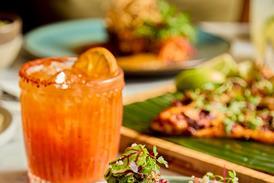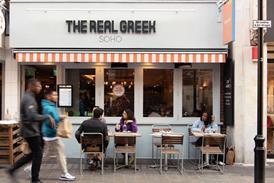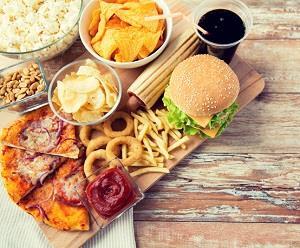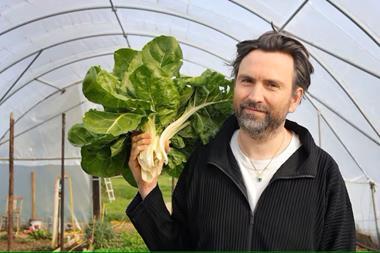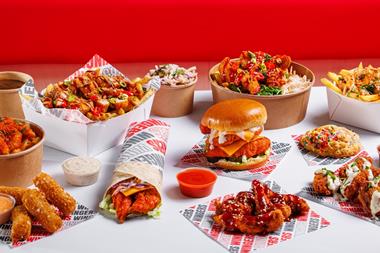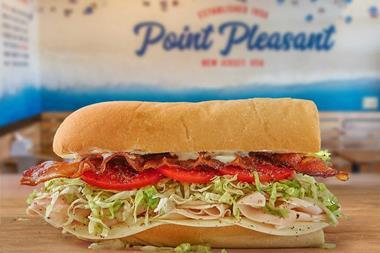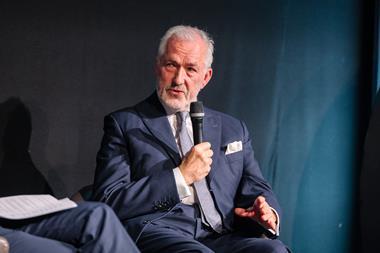There are times everyone needs a juicy bacon cheeseburger, a big portion of chips, a three piece KFC, a pepperoni pizza, lots of chocolate, a few scoops of ice cream or some crisps. Not altogether obviously, that would be far too delicious. But individually, and as an occasional treat, where’s the harm?
The trouble is the UK has long suffered from a lack of restraint. Couple that with our love of takeaways and a national diet rooted in stodgy classics and we have reached a point where the government estimates that 63% of adults in England are overweight or obese. It says one in three kids leaves primary school overweight or obese. Obesity related illness costs the NHS over £6bn every year. Those are big fat stats.
It’s pointless playing a blame game because no single factor is responsible. You could point fingers at feckless parents or an education system that wiped home economics from the curriculum, the unhealthy aspects of cheap processed food or the fact that fresh fruit and vegetables are relatively expensive, but there are many elements to the equation.
All that’s really needed is recognition that the UK has a problem with obesity and that something needs to be done to reduce it. And whatever is currently being done to address the situation isn’t working, the obesity issue has been around for a very long time.
You’ll remember Julie Critchlow, the mum who reacted to Jamie Oliver’s attempt to introduce healthier school food by passing burgers and pies to pupils through the school fence. That was in 2006. So nearly 15 years on, if one in three kids are still leaving primary school overweight, whatever progressive strides have been made are not enough.
So to the latest plans, which sound an awful lot like the old plans that were mooted then shelved, include mandatory calorie counts on menus and a ban on advertising junk food before 9pm – and also a new suggestion to include calorie counts on alcohol.
“We’ve been here many times before,” UK Hospitality CEO Kate Nicholls told MCA’s The Conversation on Monday. “It’s the end of a very long and protracted consultation.”
However, she thinks there is still an “opportunity to talk to the government about how they implement calorie labelling on menus and how they support the sector in doing it, rather than just an imposition of a blanket requirement. And it would be a very costly requirement for many businesses, because the suggestion that it only applies to large companies is just not true.”
Nicholls estimates the biggest chains spend up to £40,000 on a new menu run. She also believes any suggestion that it’s “simple and easy to administer is also not true, given that it’s going to be backed by Trading Standards officers going in and inspecting people and checking the calorie labelling is correct. So there are ways and means of doing this in a way that could be less of a burden.”
As well as the cost and that administrative burden, there are also practical problems, like cooking from scratch and hitting a consistent calorie count every time, or how to accurately count the calories in an ever changing array of daily specials. Even, Nicholls says, something as simple as “one chef that’s going to be heavy handed with the chips. How can you account for that when you’ve got to have a precise calorie count on the menu?”
Then there is the timing. Clearly this is not a good time for a sector fighting for its future to absorb any other challenges however worthy they are. It could do without any distractions, let alone ones that will cost it money it doesn’t have.
The announcement also comes as a surprise. Even though the debate is a longstanding one, and the public health lobby is very vocal, and there clearly is an obesity issue to address, Boris Johnson was always against anything resembling a nanny state. But his brush with death courtesy of the coronavirus, which is much more deadly for obese people, appears to have made him change his mind.
“I don’t think it’s the end of the debate, but I do think it is clear that the government is going to be moving ahead with this when just a year ago Matt Hancock was doing his very best to try and bury it because Boris Johnson had signalled that he wasn’t a supporter of Theresa May’s nanny state,” says Nicholls. “We now have a nanny state intervention and additional measures being looked at, so I think it’s a serious statement of intent.”
Healthy offer
It’s true that this government may not currently spring to mind as one adept at handling anything to do with health. But clearly an obesity problem does exist in the UK, and because no government can actually stop any individual eating and drinking whatever they please as often as they like, the only tactics available are persuasion, education and awareness.
So it might be time consuming, expensive and problematic, but adding calorie counts to menus does increase awareness of the calorific content of the food in question, and it doesn’t have to be bad news. Depending on what’s on the menu, adding calorie counts may allow an operator to extoll the virtues of its healthy offer, says Tortilla MD Richard Morris.
Tortilla already does via a nutritional calculator on its website that counts the calories of any combination of wrap, taco, meat, vegetables, sauces or topping that you can order at Tortilla.
“We always wanted to be able to sell ourselves as a business that was able to provide a treat,” he says. “That might be a highly calorific meal if you want a big boy burrito with all the trimmings, but we were also keen to explain to people that you’re also able to choose a very healthy chicken burrito. So the reason we wanted to do it was to highlight how healthy our food can be.”
Plenty of other operators also have calories on menus or nutritional information available online. And as well as highlighting the healthier options on a menu it can be eye-opening to see just how many calories can be carried on a single dish. Order an Ultimate Mixed Grill at Harvester and you’re devouring 2,857 kcals. That’s around six Big Macs.
It may be an extreme example, and you could argue that anyone ordering a 1/4 chicken, an 8oz steak, a half rack of ribs, 7oz of gammon, two sausages, two eggs, two slices of black pudding, chips, onion rings, tomato and peas for dinner deserves an XL coffin, but seeing the colossal calorific content may give even the hungriest diner pause for thought.
Especially when they could see they could order an 8oz steak, chips, southern fried onion nest, tomato, mushroom & peas for 531 kcals. Or maybe it’s a shame that when people go out to enjoy and treat themselves they may feel guilt tripped into swerving the indulgent stuff.
Brains CEO Alistair Darby says in his experience, reaction from customers to calorie counts on menus is mixed. “I’ve been here before when I was at Marston’s, Harvester and M&B and we put calorie information on menus and we got as much irritation as we did congratulations. You get an equal response from consumers, some say this is really helpful because it enables me to make intelligent choices, others say I’m coming out for a relaxing treat, I don’t want calories shoved down my throat, thank you very much.
“I really worry about this nanny state approach that somehow all adults are idiots and you need to put information in writing everywhere. Adults aren’t idiots, they’re perfectly capable of making decisions, so provide the data for them online in an easily updatable way and don’t destroy what is wonderful about pubs and restaurants.”
Morris says “in principle” he’s a “big supporter of all of this, because I think obesity is a massive problem and I think any form of education, or anything that helps in the long run, is a good thing. I think the government is going to try and help us, but it does need to be aware of the implications, because the administration of these things is quite long and quite torturous. There’s a lot of work involved, we had a couple of people on it full time for a couple of months.”
And he also thinks the timing is terrible. “At this stage, when many operators are actually trying to keep their businesses open, it takes away from the seriousness of the situation we are currently in. Let’s move on to this at a stage when there’s some stability back.”
Ads
Advertising works. Domino’s wouldn’t sponsor prime time Saturday night TV if it didn’t. So no doubt a pre-9pm ban on advertising junk food, defined by the government as products high in fat, sugar and salt, will reduce sales, although to what extent remains to be seen.
The government says WHO research shows exposure to junk food ads can affect what and when children eat, both in the short term and the longer term, by shaping children’s preferences at a young age.
It also says analysis published by Cancer Research UK in 2019 found almost half (47.6%) of all food adverts shown over the month on ITV1, Channel 4, Channel 5 and Sky1 were for junk food, rising to 60% during the 6pm to 9pm slot, which it says is peak time for kids watching TV.
That might all be true, so it looks like a straightforward decision, but the government will face a huge pushback by those channels if so much of their advertising revenue will potentially be wiped out by a ban, and operators like Domino’s, who clearly spend much of their advertising budgets at precisely those times, won’t be thrilled either. But the government plans to do so by 2022 and will also shortly launch a consultation about junk food advertising online.
Alcohol
One new proposal is to add calorie counts to alcohol, and it’s possible that the calorific content of booze is more of a mystery to many than burgers or pizzas. Infamously, drinking a large glass of white wine is roughly the same as eating a Cornetto. Maybe those that were unaware of the calorific content of alcohol – the government says up to 80% of adults do not know the calorie content of common drinks – will make people drink less, or opt for a healthier tipple, and maybe that is a good thing for the health of the nation.
But Darby says people “go out to get some space, socialise and have a good time. I think it’s all a bit depressing if the first thing you see when you go to a pub is something that says ‘this pint of beer contains 389 calories’. It does make life a bit joyless.”
He also says “we’re not getting any evidence that people actually asked to know what the calories are in alcohol. If people are concerned about how many calories there are in alcohol, then the way to do that is to make that information digitally available. That’s is the way forward because then you get the best of both worlds.”
Having calorie counts available online rather than having it printed on menus does seem to be a far more workable solution for the industry, even though the health lobby would argue that it won’t give people the calorific content when they are deciding what to choose, rendering it useless.
Expect the debate to rumble on, just as it has done for years. Although the government has tied the coronavirus into it now, the policy document describes the pandemic as giving the obesity debate a “wake up call” because obese people are far more at risk from the virus. So in that respect the timing is topical.
With takeaways on the up in tandem with the public currently living a lockdown-enforced sedentary lifestyle, in terms of the health of the nation it’s a timely thing too. Henry Dimbleby also launches part one of his National Food Strategy today. But clearly, at a time when the hospitality industry is on the floor, for this sector the timing is poor.
Precis
ANALYSIS
Big fat stats put the obesity debate back on the menu
There are times everyone needs a juicy bacon cheeseburger, a big portion of chips, a three piece KFC, a pepperoni pizza, lots of chocolate, a few scoops of ice cream or some crisps. Not altogether obviously, that would be far too delicious. But individually, and as an occasional treat, where’s the harm? The trouble is the UK has long suffered from a lack of restraint. Couple that with our love of takeaways and a national diet rooted in stodgy classics and we have reached a point where the government estimates that 63% of adults in England are overweight or obese. It says one in three kids leaves primary school overweight or obese. Obesity related illness costs the NHS over £6bn every year. Those are big fat stats.














